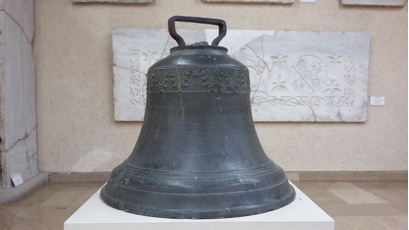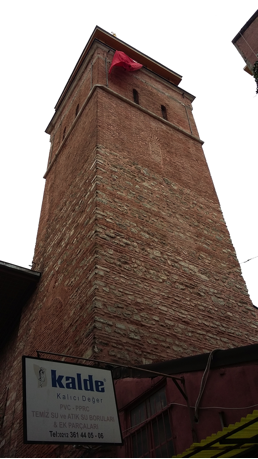
ANAMED 2015–2016 Fellow Alex Rodriguez Suarez writes about his research on bell-ringing in the Byzantine Empire. Linking his research to ANAMED’s new exhibition ‘Everyday Sounds: Exploring Sound Through Daily Life’, he asks, ‘How can everyday sounds be part of the history or the heritage of a city?’
Because my research focuses on bell-ringing in the Byzantine Empire, the fellows at the ANAMED have labeled me “the bell guy”. To be honest, a few years ago I would never have imagined that I would end up working on such a topic. Nonetheless, there is a problem. The study of bell-ringing is mainly based on bells, percussion instruments usually made of bronze, and bell-towers, the buildings where bells were hung and rung.
Unfortunately, almost all bells and bell-towers from the Byzantine period in Istanbul have vanished. In fact, there is only one bell-tower standing. The structure was built for the church of San Domenico (today Arap Camii), a Gothic church completed in 1325 and located in Galata, the Genoese quarter of the Byzantine capital. Today it functions as a minaret. Likewise, there seems to be only one surviving bell – at least so far! – dating from the period before the conquest of Constantinople by the Ottomans (1453). This bell, most likely of Genoese production, is on display at the Istanbul Archaeological Museums (Istanbul Through The Ages gallery, no. 5127) and apparently comes from the Turris Sancti Crucis, a.k.a. Galata Tower, a fourteenth-century construction and the most imposing part of the walls surrounding the Genoese settlement. If this is the case, this bell did not have a religious function because this famous structure, today a major tourist attraction in Beyoğlu, was not the bell-tower of a church or a monastic complex.
How can one study Byzantine bell-ringing with such scanty material remains? Luckily, bell-ringing is more than bells and towers. At the ANAMED, I have realized that bell-ringing is not simply about material culture; bell-ringing is also about how people experienced soundscapes (bell chimes), and even sights (towers). In Istanbul I have discovered that soundscapes and, senses in general, have been in the academic spotlight for some time, and as the new exhibition at the ANAMED – Günlük Sesler / Everyday Sounds – demonstrates, this intangible heritage has become more trendy, with scholars taking it more seriously.

Yes, all this research about experiencing is often criticized for its abstraction and immateriality. How can everyday sounds be part of the history or the heritage of a city? Perhaps the reason why we may be reluctant to accept soundscapes as a serious topic of research is their everyday dimension. Too many times when we study past empires and civilizations we tend to focus on their grand achievements. We display their treasures in museums so we can admire their skills and beauty standards. Also, we translate their documents in order to understand their ideas and beliefs. We usually forget less impressive aspects of the past; for instance, everyday sounds. This is not surprising because today we barely pay attention to these sounds; we know their meanings and we take them for granted; we even find them annoying at certain times. The muezzin’s call, the tolling of bells, the horn of the tram along Istiklal, the screams of the lottery seller and the street performers’ music.
The study of these past soundscapes should then begin by raising awareness about the soundscapes that surround us today. The new exhibition at the ANAMED will indeed contribute to this aim. Hopefully the visitors will make an effort to listen and will understand the concept behind the different installations, it certainly requires patience and insight. Going back to my research on bell-ringing, it is possible that my project may in the end yield very humble results; however, by learning about this sensory approach to history and heritage, I can already say that I have grown as a scholar.

